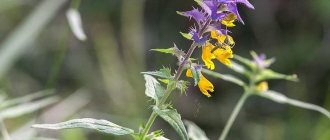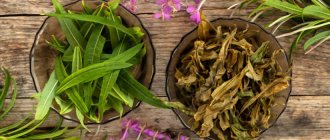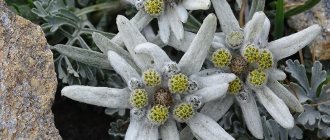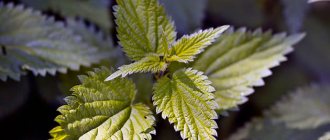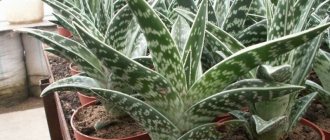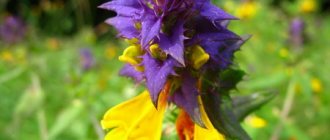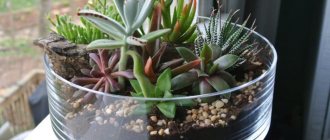Author: Elena N. https://floristics.info/ru/index.php?option=com_contact&view=contact&id=19 Category: Garden plants Published: October 22, 2017Last edits: January 20, 2021
- How to collect
- Beneficial features
fireweed herb or narrow-leaved willowherb, or Koporye tea (lat. Chamerion angustifolium = Epilobium angustifolium) is a herbaceous perennial, the type species of the genus Willowherb of the Fireweed family. Among the people, fireweed has many other names: woodpecker, magpie-eyes, fireweed, fireweed, sage grass, virgin herb, Kuril tea, wild flax, weeping weed, sageweed, weeds, tar, sweet clover, wheatgrass, field sage... Ivan grows tea throughout the Northern Hemisphere in light forests, on the edges and clearings, along ditches and embankments, near water, on damp soil and in dry sandy places. It first appears in burnt areas and clearings and dies out as other plants appear there. Fireweed often grows next to raspberries.
Composition of fireweed
Ivan tea is rich in beneficial elements that have a healing effect on the human body as a whole. It contains many vitamins, for example, C, B, P.
Thanks to this, fireweed preparations help increase immunity, improve the appearance of the skin, activate brain activity, and strengthen blood vessels and capillaries.
Contains fireweed and beta-carotene, pectin, lectin, tannins. It also contains microelements, such as:
- iron;
- copper;
- nickel;
- titanium;
- manganese;
- boron
Fireweed has a beneficial effect on the hematopoietic system, bones, kidneys, liver, and heart. In addition, it enhances the production of sex hormones.
The main advantage is that fireweed tea contains neither oxalic acid nor caffeine. The amount of nutrients in a plant can vary, as it depends on the time and place of collection of the herb, as well as on the method of its processing.
Drying
The best way to dry tea is definitely in a Russian oven. Can be dried in the sun, in the oven or in a vegetable dehydrator.
Before drying, hand-rolled “sausages” should be cut into circles 0.5 cm thick.
Oven drying
Preheat the oven to 1000 C. Cover the baking sheets with parchment paper and scatter the raw materials on it in a thin layer. The height of the layer should not exceed 1 cm. Spread the foliage of Ivan tea in an even layer, without lumps, over the surface.
Place the baking sheets in the oven, leaving the door ajar. Leave the tea to dry for 2 hours. From time to time, the leaves need to be stirred so that they dry evenly.
Properly dried tea leaves should not be soft, they should break well and look like the varieties of loose leaf teas we are used to.
Properly dried Ivan tea does not have a strong odor. The aroma and taste are revealed when they are brewed.
A few minutes before the end of drying the tea, you can slightly increase the temperature. Then the tea will brown like coffee beans, which will give the tea taste additional piquancy and depth.
Drying in an electric dryer
This option is the easiest and fastest. The only downside is that there is not enough space in the dryer. To dry a large volume of tea, you will have to lay the leaves several times.
Place a thin layer of Ivan tea leaves on the dryer trays. Set the drying mode to “herb drying” or set to a temperature of 50-700 C. Drying time is 30 minutes. Periodically you need to check the condition of the tea leaves so as not to dry out the tea.
Air drying
This method is the longest and most labor-intensive, but allows you to preserve the valuable substances in the brew as much as possible.
Drying raw materials in the open sun is not permissible.
Spread the leaves evenly over the surface in a thin layer and leave to dry for several days. The tea needs to be stirred to dry evenly. It is worth taking care to protect the foliage from insects and birds so that they do not clog or spoil the tea.
Who is contraindicated from using fireweed?
Like any medicinal plant, fireweed tea has contraindications. It should not be given:
- children under 2 years old;
- persons suffering from allergies to this herb;
- people with diarrhea;
- pregnant women;
- people with low blood pressure.
It is better not to use the infusion together with antipyretic medications. And, in general, for your peace of mind, before you start drinking fireweed, you need to consult a doctor.
Treatment of gastritis and stomach ulcers
Preparation of the decoction: pour 3 tbsp. l. dry herbs with 1 cup of boiling water, bring to a boil and boil for 10 minutes, cool, strain and drink warm, 2 tbsp. spoons 3 times a day before meals.
This decoction is also used to treat other diseases: for headaches, gargle several times a day for tonsillitis, and make lotions for quick healing of wounds.
Ivan tea contraindications
The herb is safe and side effects occur with an overdose. Do not drink more than 1 glass of tea per day. After a month, take a break for 3-4 weeks.
Use with caution in case of gastrointestinal dysfunction, excessive blood clotting (people at risk of varicose veins and blood clots), and infants.
Method one
Required:
- fireweed tea (dry mixture) – 2 tsp;
- water – 0.5 l.
To boil water. Place the herb in a large mug and pour boiling water over it. Close the container tightly and leave to brew for 10 – 15 minutes.
Mix the broth thoroughly. Use it within 1 – 2 days.
| To obtain a unique taste and aroma of tea, use an antique coal samovar. In such a samovar, tea will retain its healing properties in the best possible way. You can buy a samovar on the website https://samovarkino.ru/samovary |
Growing and care on the site
Ivan tea can be grown in a summer cottage. This plant is famous not only for its medicinal properties, it is also visually attractive. There are two popular methods of growing fireweed.
From seeds
You can buy seeds or prepare them yourself. Collection time is early autumn, 1-2 months after the perennial blooms. The seeds must be thoroughly dried, removing fluff from them. Store in a dry, dark place.
For seedlings, seeds are sown in boxes in early spring. The seeds are very small; if they are sown immediately in the ground, they will be washed away by rain or blown by the wind. The soil for planting needs loose, light soil. Mix river sand, humus and peat in equal proportions. It is not recommended to deepen the seeds; it is better to scatter them over the surface of the soil substrate and “water” them generously from a spray bottle. Cover the box with glass or film and place in a warm place (the temperature for germination should be at least +20 degrees). The first shoots will hatch in about five days.
The seedlings dive when two true leaves appear. Planted in open ground in the first days of summer. Before planting, the seedlings are hardened off by placing them in fresh air for 3 days.
Tip: seedlings should be planted on a cloudy day (preferably in the rain). In the sun, young plants will wither and may even die.
Vegetatively
A simpler method, unlike the previous one. The perennial grows in forest clearings, along roads, and near reservoirs. You can dig up its roots and plant it on your site.
The root system of the medicinal crop is spreading, so it is better to dig it up with a lump of earth. The rhizome is placed in a shallow hole, where humus, sand and ash are first added. After planting, water thoroughly. The top of the soil is mulched with straw or dried grass.
Fireweed transplanted in this way quickly takes root in its new location.
Caring for a flower is not difficult.
The rules of care are as follows:
- the place for growing perennials must be sufficiently lit;
- Water sparingly, depending on the weather. Once a week in the evening or morning during intense heat. A plant from a meadow usually gets enough rain;
- loosen the soil after watering once a month;
- One mineral fertilizing per season is enough;
- for the winter, the stem of the fireweed is cut off, leaving a petiole 15 cm long from the soil;
- A good place for planting is near a fence or outbuilding, in which case the plant will not be damaged by the wind.
Tip: Fireweed grows very quickly. To prevent it from extending beyond the designated area, it must be fenced underground. To do this, iron sheets or slate are dug along the perimeter of the flowerbed to a depth of about 1 meter.
Ivan tea blooms in the second year no matter how it is planted. Flowering period: end of June – mid-August. The pubescent seeds ripen after flowering. To prevent the seeds from being blown across the garden plot by the wind, they must be cut off before they ripen.
Insect pests do not grow on fireweed; it also has good immunity to diseases. Ivan tea improves the condition of the soil on which it grows.
Where does fireweed grow?
The advantage of Ivan tea is that it grows throughout our country. It can be found in any area - near roads, in the forest, in the garden, meadow, clearing. The height of this plant can reach up to one and a half meters.
The flowering period occurs in the second half of summer. It was then that it was customary to harvest this herb and it was at this time that fireweed becomes honey-bearing. His honey is very healthy.
It is optimal to collect fireweed in the forest or in fields located at a considerable distance from the highway and highways. The blank is long leaves.
Botanical description
Angustifolia fireweed reaches a height of 50 to 200 cm. It has a thick creeping rhizome, on the roots of which, both vertical and horizontal, many additional buds develop, promoting vegetative propagation of the plant. The stem of fireweed is simple, round, erect, densely leafy and bare. The leaves are alternate, simple, sessile or short-petioled, linear-lanceolate, pointed towards the apex, and wedge-shaped or almost rounded towards the base, entire or finely glandular-toothed along the edge. The leaves of fireweed are dark green and shiny above, pale pink, purple-red or bluish-green below, they reach 12 cm in length and 2 cm in width.
Bisexual, four-membered pale pink or white fireweed flowers with a nectar ring around the style are collected in a sparse apical raceme from 10 to 45 cm long. Flowering begins in the second half of summer and lasts a little over a month. The fruit of fireweed is a pod-like capsule with bare oblong seeds that ripen in late summer or early autumn.
Fireweed is cultivated as a fodder crop and as a medicinal plant, since the medicinal properties of fireweed have been known for a long time. In addition, fireweed is the best honey plant among all the herbaceous flora of forests.
- Picking petunia into seedlings - visual instructions from an experienced gardener
Features of collecting this medicinal plant
When to collect fireweed? This should be done in July and August. Moreover, this must be done before the flower fades. Only leaves are collected. It is advisable to prepare more of them, since fermentation and drying lead to a significant change in their volume.
- Kitchen accessories: examples of modern options + instructions on how to choose
Maryin root: planting, care, cultivation, medicinal properties and characteristics of the plant (140 photos)
Monarda: types, varieties, planting in open ground, care and cultivation with your own hands (155 photos and video tips)
How to collect and dry fireweed? It is necessary to select whole, clean, healthy leaves. Spoiled, diseased and defective leaves are not suitable. In some cases, both stems and roots are used to prepare preparations. When collecting leaves, you can add a small number of flowers to them.
Now let's figure out how to dry Ivan tea. Drying the plant should take place in a draft. It is better to use paper bags for storage. The herb can be stored for two years.
If you decide to prepare roots, then you should dig them up in the fall. They need to be finely chopped and dried thoroughly. The permissible storage time is three years. The most delicious tea is produced by fermented leaves.
Caucasian
Caucasian fireweed is an ornamental perennial herbaceous plant, the height of which is 10-50 cm. Its stems are bare, extending from the base, can occasionally be creeping, the leaves have a linear-lanceolate shape, their length is 3-5.5 cm . The petals of Caucasian fireweed flowers are round, and the flowers themselves are quite large (up to 3 cm), collected in short racemes.
Photo.
Western Caucasus, Stavropol Territory, Adygea - this is where you can find this plant. The main places where fireweed grows are river valleys, pebbles, and the alpine belt.
Tips on how to drink fireweed correctly
Already in Ancient China they knew that the tea ceremony was a real art. Drinking tea was always accompanied by heart-to-heart conversations. This made this procedure a pleasant pastime. In addition, tea has a relaxing effect, giving peace and tranquility. It is better to drink it without sweetening it.
If you have a sweet tooth, you can drink the drink as a snack with dried fruits. The healing properties of fireweed after brewing last only a couple of days, so it is better to drink the tea before this time has expired.
Castor bean: planting, growing, care and maintenance at home and outdoors (115 photos and videos)Bergenia - tips for properly growing a medicinal plant. Features of collection, application and contraindications (130 photos and videos of planting in the ground)
Cloudberries: beneficial properties, features of cultivation and use. Planting, care and propagation with your own hands (150 photos and videos)
Ivan tea is not only useful, but also quite a beautiful flower. Therefore, you can safely allocate a small plot in your dacha for growing it.
broadleaf
Broad-leaved willowherb (broad-leaved willowherb) is a herbaceous plant whose habitat is the northern regions of the Northern Hemisphere, arctic and subarctic zones. The length of the leaves of this fireweed is from 1 to 10 cm, the leaves look different - they can be spear-shaped or, on the contrary, oval.
Photo.
Depending on this, at the ends they are rounded or pointed, sometimes they have a small hairline .
Broadleaf fireweed flowers are collected in a brush; they are usually presented in dark pink tones, but occasionally they are also white. This plant is of considerable practical importance for the indigenous inhabitants of the northeast of Russia and North America, especially for the inhabitants of Chukotka, as well as Greenland. They use fireweed tea for food: the leaves are brewed as tea (fruits and flowers are also added) or used raw, for example, for salad with walrus fat. In addition, broadleaf fireweed is the national flower of Greenland.
Medicinal properties
With constant use of Koporye tea, you can get rid of a number of the following diseases: • Anemia. • Gastritis, ulcer, colitis, pancreatitis. • Inflammation of the prostate gland or prostatitis. • Infertility. • High blood pressure. • Urolithiasis and inflammation in the bladder. • Changes in the ENT organs – tracheitis, pharyngitis, sinusitis, bronchitis. • Dermatology. • Pathology of the spleen. • Herpes. • Metabolic-inflammatory skin disease. It is recommended to use infusion and decoction of Koporye tea in the following cases: • In case of poisoning and intestinal dysfunction. • In case of disruption of the nervous system. • For epilepsy. • For rehabilitation from alcoholism, as well as for hangover syndrome. • With an enhanced psychological and emotional state. • For fatigue and overwork. • During the appearance of baby teeth in children. • For endocrine disorders in women. • As an additional means to fight cancer and tumors. • In the treatment of blood diseases. • With reduced immunity and vitamin deficiency.
Ivan-tea for men and women
The healing properties of this plant will help not only men and women, but also children. Ivan tea can cure prostate adenoma and prostatitis, so it has become very popular among men of all ages.
For women, this plant is an essential assistant in the treatment of cystitis, diseases of the genitourinary system and thrush.
Tea from Ivan-tea
Koporye tea is a drink that has a pleasant taste and smell. However, in order to prepare truly healthy tea, you should use only high-quality water. If a person has tried tea with melt or spring water, he will never be able to forget its taste. Five grams of tea per person per day. Since the first time the tea turns out to be very concentrated, it can be brewed several times, while the taste of the tea will be preserved.
